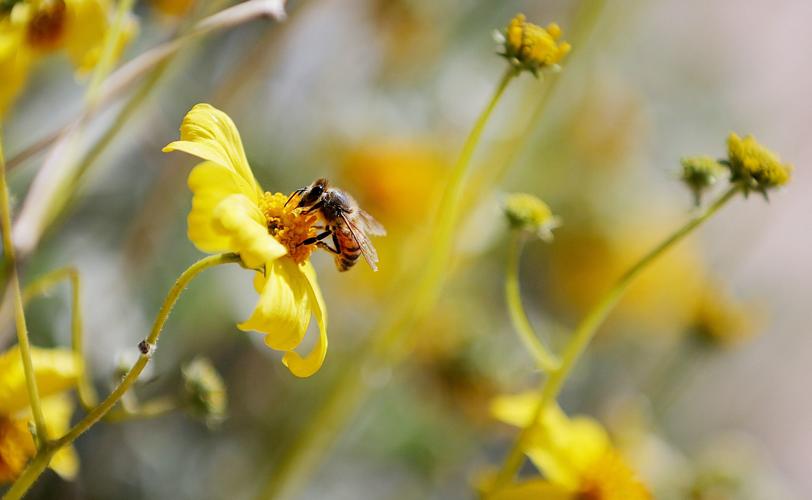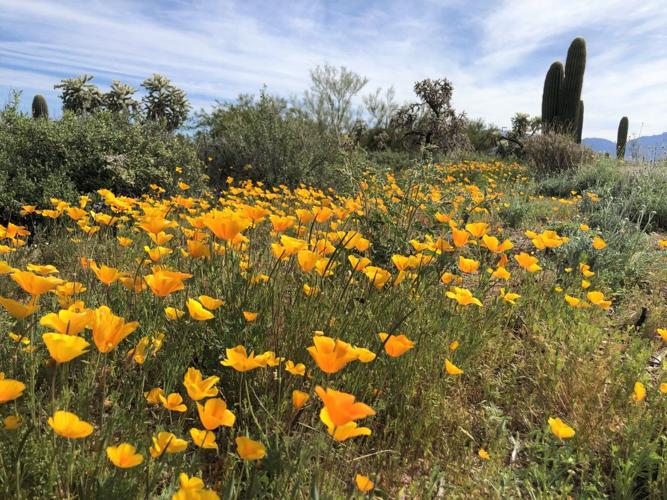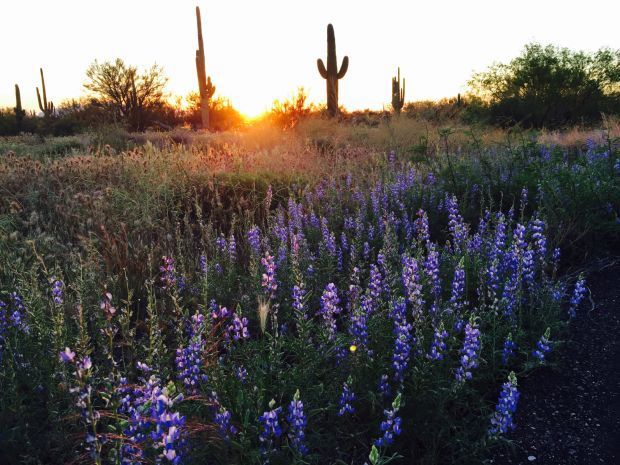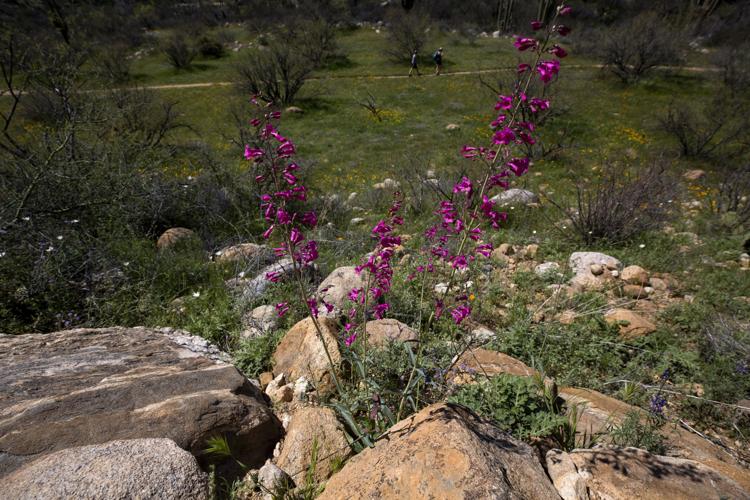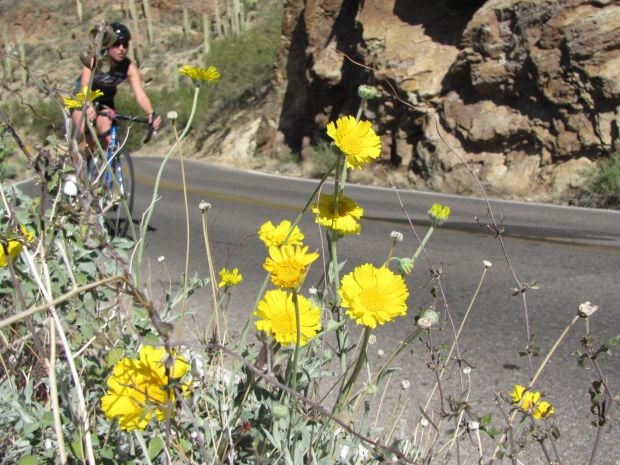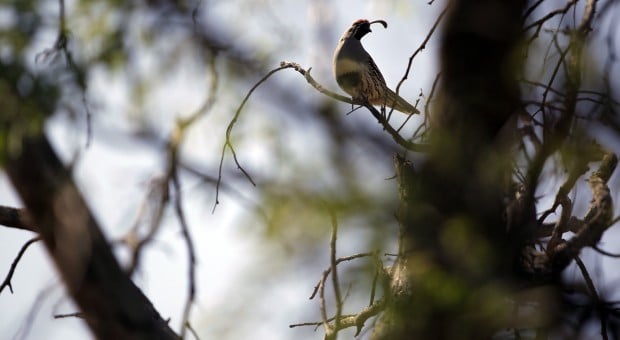So, in the name of social distancing and also not going stir crazy, you're taking another walk through your neighborhood.
Us, too.
We are so thankful it's spring in Tucson. Because, global pandemic or not, the birds are still singing, and the wildflowers are still blooming. Let's just take this one day at a time. Deep breaths, everyone.
As you continue your neighborhood wanderings this week, add some education to your exploration. Here's a guide to some of the most common birds and wildflowers you may encounter.
Flowers

Wildflowers line the paved pathways at Tangerine Sky Community Park in Marana, March 5, 2020.
Mexican gold poppies: You'll find these brilliant, orange cup-shaped flowers growing from a plant with fern-like leaves from around March through May. These poppies are a subspecies of the California Poppy, and it's pretty difficult to tell the two apart, according to a guide by the Lady Bird Johnson Wildflower center in Texas.

Bright yellow brittlebush blooms in profusion along the Babad Do’ag Trail, sharing the slopes with saguaro cacti.
Brittlebush: During the non-blooming seasons, the brittlebush is an unassuming little shrub hanging out along slopes and hillsides. But as spring approaches, long stalks will grow out of the plant and small yellow flowers will blossom. You can find flowers blooming from late winter to early spring. This shrub is a member of the sunflower family! 🌻Read more brittlebush facts from the Arizona-Sonora Desert Museum here.

Take the "Drive-Less" pledge for healthy air and you could win a $100 gift card (Sponsored)
If you (like us) are driving way less these days, you are already helping Tucson's air quality. By skipping just one commute trip in your motor vehicle each week — by carpooling, taking transit or riding a bike instead — you can reduce air pollution about 1,000 pounds a year and help keep the air healthy for those you care about.
When we drive less we'll all win with cleaner air to breathe, and if you take the "Drive-Less" pledge you might win a $100 gift card! Read the Healthy Air Is In Our Hands Campaign and Contest Rules and then take the pledge for cleaner air.
Take the pledge today!

Lupine: There several species of lupine you can find in the Southwest. Most are identified by their their small, purple-blue flowers and slender stocks.

Globe mallow. Photo taken along the Catalina Highway on March 12, 2013.
Desert globe mallow: Orange globe mallows grow in sandy or gravelly soil, so you're likely to see these roadside. Globe mallows are perennials and look like a shrub, according to the Arizona-Sonora Desert Museum. These bloom mostly in spring, but can be coaxed to bloom during other parts of the year, depending on rainfall.

A Penstemon stands next to a trail on the Sutherland Trail in Catalina State Park, 11570 N. Oracle Rd., in Oro Valley, Ariz., on March 15, 2020.
Parry's penstemon: These bright pink flowers on tall stalks are beloved by hummingbirds. You're most likely to see them from late winter to early spring, according to Civano Nursery.

A cyclist on Gates Pass west of Tucson pedals past desert marigolds in brilliant bloom smack in the middle of winter.
Desert marigold: These yellow flowers have long stems that branch out from gray-green leaves. Desert marigolds are perennials and love sandy or rocky soil, which is why you see them roadside, according to the Arizona-Sonora Desert Museum. They mainly flower in the spring, but you might also catch them blooming other times of the year due to rainfall and humidity, according to Civano Nursery.
Birds
Verdin: These year-round desert dwellers make those big nests of sticks in palo verde and mesquite trees. They're tiny song birds that have a three-part call that likely everyone in Tucson has heard, says Jennie MacFarland, a bird conservation biologist with the Tucson Audubon Society. They're small and gray with yellow faces — like they dipped it in mustard, MacFarland adds.
Hummingbirds: Tucson is a hummingbird haven, with four that you're likely to spot flitting around your neighborhood. You can spot Anna's Hummingbird for the males' bright pink faces. Male Black-Chinned Hummingbirds have a black throat with a bottom stripe of glittery purple. Male Costa's Hummingbirds have bright purple faces, and male Broad-Billed Hummingbirds have red bills and blue-green bodies with broad, blue tales, MacFarland says.

A Costa's hummingbird sits in a nest in the hummingbird aviary at the Arizona Sonora Desert Museum in Tucson, Ariz., Friday Mar. 7, 2008. Photo by Greg Bryan/Arizona Daily Star
Phainopepla: If you've got mistletoe, you've probably seen these guys. The males look like shiny, black cardinals, and the females are a more subdued gray, MacFarland says.

A male phainopepla with a nice gloss hangs out in a mesquite loaded with desert mistletoe at Sabino Canyon.
Lucy's Warbler: You're more likely to hear these than seen them. MacFarland says they just arrived in Tucson, and you can hear them singing everywhere. They're gray all over and the males have a bit of a rusty color on their head and the base of their tale. They ❤️mesquite trees.
Gambel's Quail: We've all seen these speedy little friends scurrying through the desert, a trail of babies trotting behind them. MacFarland says they're just beginning to lay eggs now.

Lesser Goldfinch: This is another songbird with lots to say. The male has a yellow belly with a black back, and the female is a pale, lemon color, MacFarland says.

This pretty Lesser Goldfinch bird was hanging out on this limb as a number of bird watchers were up early this morning checking it out as they took part in the "Wake Up With The Birds" walk at Agua Caliente Park Thursday September 5, 2013) in Tucson, Arizona. Photo by Benjie Sanders / Arizona Daily Star.


